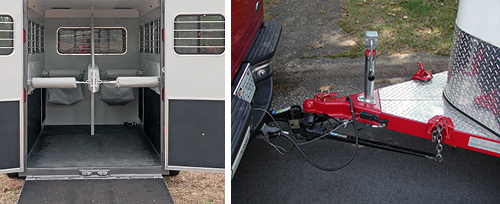Smoother Trailer Ride = Less Stress on Your Horse
 EquiSpirit Trailer Co. Trailer Tips
EquiSpirit Trailer Co. Trailer Tips
Don’t overdo it. Adding heavier-duty, higher rated tires to your horse trailer, thinking that they will provide a higher margin of safety, can be a mistake. They will give your horses a rougher ride if they excessively exceed what the horse trailer needs to ride comfortably. To best match tires to the trailer, take the weight rating of the individual tire times 4. The total should equal or be slightly higher than the Gross Vehicle Weight (GVWR) of the trailer. (GVWR is the weight rating provided by the manufacturer that states how much the trailer can weigh with horses and still be safe.)
Do not deflate tires for a softer ride. Underinflated tires will flex more, heat up, and are more likely to blow.
Thick quality rubber mats on the floor will absorb road impact, putting less strain on the horses’ leg muscles. Rubber torsion suspension gives a smoother ride over spring and shackle axles, also reducing soreness in the horses’ legs.
Lighter weight, short wheelbase SUV’s and trucks should use Weight Distribution Systems (often mistakenly called sway bars) to eliminate “front to back” bouncing of the trailer and the tow vehicle.
Towing lighter weight trailers with oversized tow vehicles, such as a 3,500 (one ton) truck pulling a two-horse bumper pull, will tend to bounce the trailer around. When pulling a two-horse trailer with a heavy-duty truck, consider a gooseneck versus a bumper pull since the gooseneck trailer is 1,000 plus pounds heavier.
Cushioned couplers, especially on Gooseneck trailers, soften the impact of the truck springs, which are typically located directly beneath the nose of the trailer. A cushioned coupler provides a smoother ride and reduces stress on the trailer frame.
Speeding up gradually and slowing down gradually along with making wide slow turns will give horses time to brace and balance correctly.










